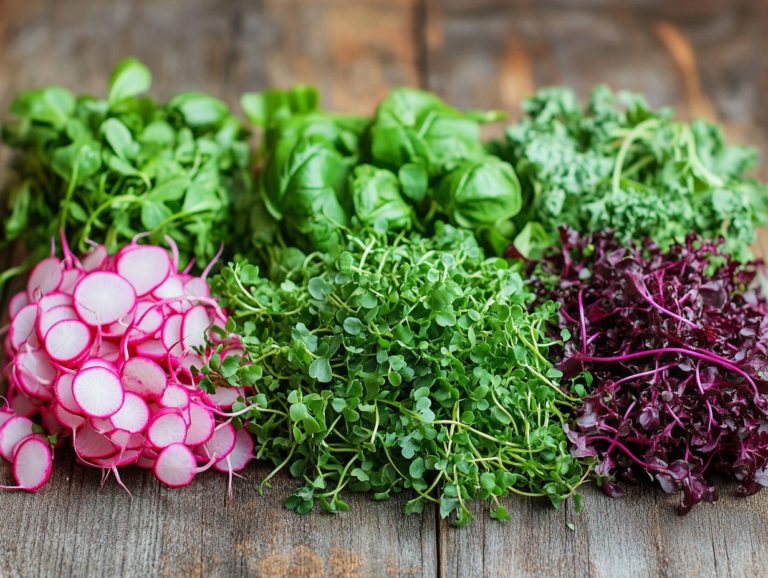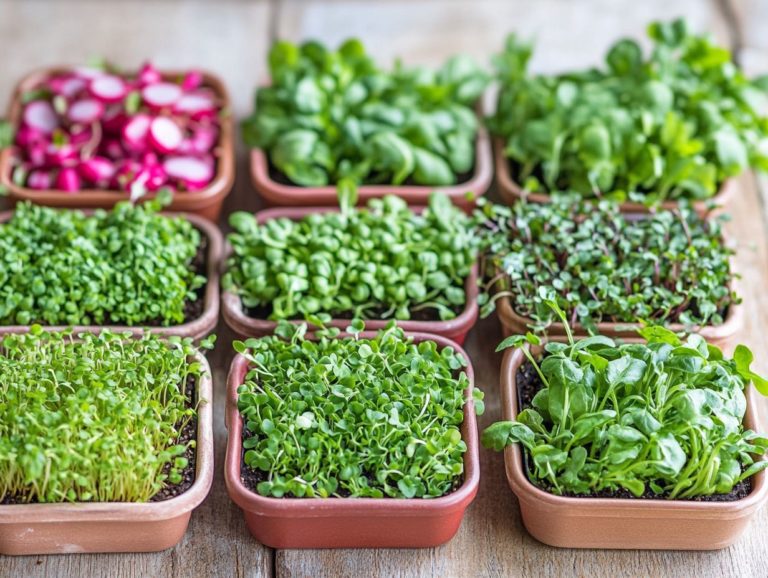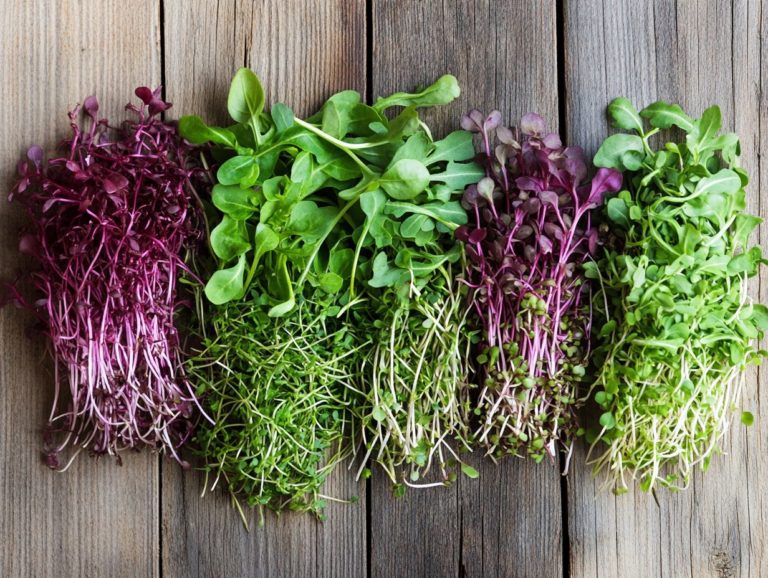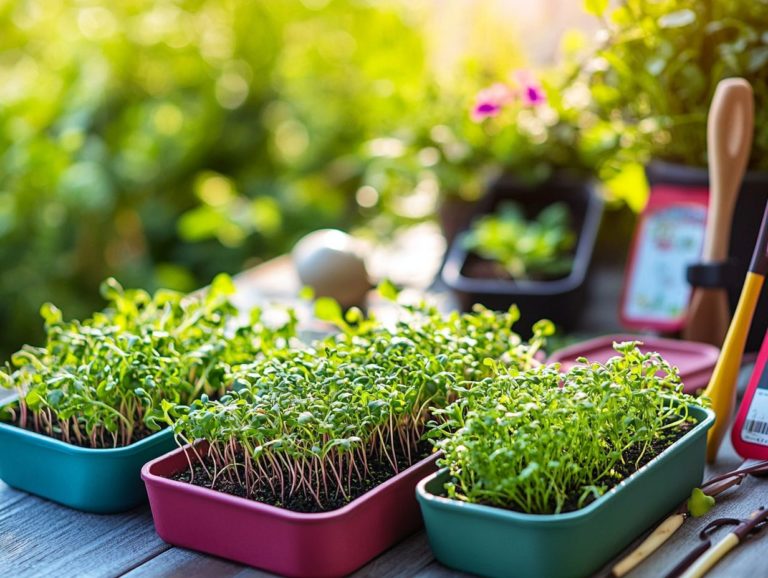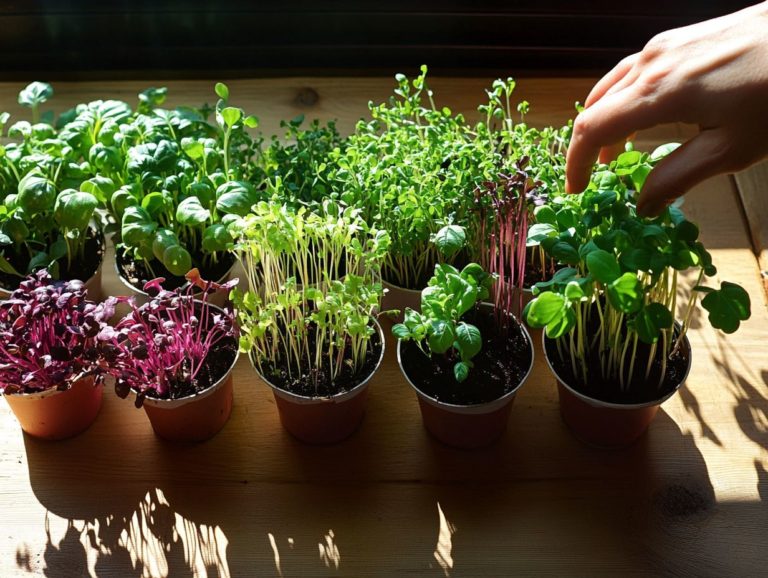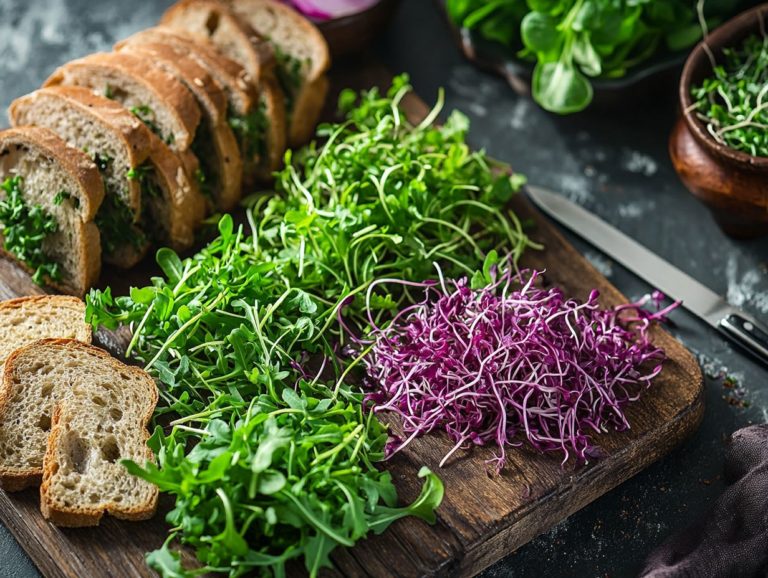Microgreen Varieties That Thrive Indoors
Microgreens are delightful, nutrient-dense plants that pack a flavorful punch, making them an ideal choice for your home gardening endeavors, especially for indoor microgreens.
Cultivating them indoors offers convenience and allows you to savor fresh greens throughout the year. This makes it a rewarding experience for every urban gardener. This article delves into the nutritional advantages of microgreens, showcases the best varieties suited for indoor growth, and offers a straightforward, step-by-step guide for nurturing them in your own space, including tips on how to grow microgreens effectively.
It also tackles common challenges you may encounter and shares valuable tips for harvesting and incorporating these tiny superfoods into your meals. Get ready to transform your meals with exciting microgreen recipes and growing tips!
Contents
- Key Takeaways:
- Benefits of Growing Microgreens Indoors
- Best Microgreen Varieties for Indoor Growth
- How to Grow Microgreens Indoors
- Common Issues and Solutions for Indoor Microgreen Growth
- Harvesting and Using Microgreens
- Frequently Asked Questions
- What are microgreen varieties that thrive indoors?
- Why do these specific microgreen varieties thrive indoors?
- Can these microgreen varieties be grown in any type of indoor setting?
- Do these microgreen varieties require any special care when grown indoors?
- How long does it take for these microgreen varieties to mature when grown indoors?
- Are there any benefits to growing these microgreen varieties indoors?
Key Takeaways:

- Microgreens are small plants packed with nutrients and are easy to grow indoors, especially popular varieties like kale, arugula, and basil.
- Growing microgreens indoors offers convenience and a constant supply of fresh, healthy greens.
- The best microgreen varieties for indoor growth are quick-growing and have high nutritional value, such as broccoli microgreens, radish microgreens, and pea shoots.
What are Microgreens?
Microgreens are young, edible treasures you can harvest shortly after germination, usually within 7 to 21 days. These vibrant little greens, like broccoli microgreens, kale microgreens, arugula microgreens, and radish microgreens, are celebrated for their stunning colors, unique flavors, and remarkable nutrient density, meaning they have lots of vitamins and minerals relative to their size.
With a wealth of health benefits, they ve become a favorite among city gardeners and professional chefs alike, often featured in gourmet dishes. Not only are they packed with vitamins and minerals, but they re also incredibly easy to grow, adding a delightful burst of flavor to salads, smoothies, and a myriad of dishes making them a staple in any health-conscious diet, particularly when using fresh microgreens.
In fact, some studies reveal that certain microgreens can contain up to 40 times the nutritional value of their mature counterparts, serving as a concentrated source of vitamins C, E, and K, along with powerful antioxidants that support overall health. Each type of microgreen boasts its own distinct flavor profile some deliver a spicy kick, like mustard microgreens, while others offer a subtle sweetness, such as sweet kohlrabi, providing endless opportunities for culinary creativity across diverse recipes.
They thrive in various conditions, from natural sunlight to artificial light, making them perfect for city gardeners eager to cultivate fresh produce year-round. Whether you elevate gourmet meals or use them as a vibrant garnish, these nutrient-packed greens enhance your dishes and diversify your diet beautifully.
Benefits of Growing Microgreens Indoors
Growing microgreens indoors presents a wealth of benefits tailored for urban dwellers and gardening enthusiasts, making it a popular choice in vegetable gardening. It allows you to cultivate fresh, nutritious produce year-round, including a variety of edible crops, all without the constraints of extensive outdoor space.
This method of indoor gardening not only grants you access to vibrant microgreens like kale microgreens, basil microgreens, and arugula microgreens but also offers a sustainable approach to enjoying organic produce. For those interested in maximizing their yield, exploring techniques for growing microgreens year-round can help elevate the nutrient content of your meals while fostering healthy eating habits.
It can also be a rewarding hobby that deepens your connection to food and sustainability, especially through the practice of microgreen gardening. Start your indoor garden today and enjoy fresh greens all year round!
Nutritional Value and Convenience
Microgreens are your secret weapon in the quest for exceptional nutrition. These tiny greens often pack a punch, containing higher concentrations of vitamins, minerals, and antioxidants than their mature counterparts. They are an essential component of a healthy diet and an effortless way to elevate any meal.
Their small size and rapid growth cycle mean you can cultivate them without needing a green thumb or vast gardening space. Whether you prefer using special mats that allow plants to grow in water without soil or organic potting soil, you’ll find fresh microgreens are just a few days away.
The nutrient density of microgreens is remarkable they can contain up to 40 times more vital nutrients than fully grown vegetables. Their diverse flavors and textures enhance your culinary creations and add a vibrant splash of color to your dishes. You can toss them into salads, use them as a garnish, or blend them into smoothies. These little powerhouses fit easily into any diet, providing a delightful way to meet your daily vegetable intake goals through delicious microgreen recipes.
Growing microgreens is a rewarding endeavor, making the nurturing process as enjoyable as the delicious, healthful results that come from caring for your microgreen garden.
Best Microgreen Varieties for Indoor Growth
When choosing the best microgreen varieties for indoor growth, such as broccoli microgreens or sunflower microgreens, the options are plentiful. You can consider:
- Nutrient-dense broccoli microgreens
- Aromatic basil microgreens
- Zesty mustard microgreens
Each variety brings its distinct flavors and textures to elevate your dishes, especially in salads and other fresh preparations. Sunflower microgreens and pea shoots also grow well indoors, making them perfect for those new to gardening. They allow you to cultivate a diverse range of edible crops in compact spaces, enhancing your indoor gardening experience.
Selecting the right microgreen mix is crucial for maximizing both flavor and nutritional content. For example, consider using lentil microgreens and mustard microgreens in your indoor gardening adventure. To explore more options, check out microgreen varieties: a guide for beginners.
Selection Criteria and Recommended Varieties

Selecting the right microgreen varieties for your indoor garden involves thoughtful consideration of several key criteria, including flavor profile, growth rate, and how well they adapt to indoor conditions, especially in varying light. Choose microgreen seeds, like broccoli or radish, that are easy to grow and well-suited to your specific environment. Take into account your available light source, temperature, and humidity levels.
Recommended varieties include:
- Radish microgreens
- Mustard greens
- Lentil microgreens
These options are known for their quick growth and robust flavors, especially for those interested in growing microgreens during the winter months. As you evaluate your choices, assess how each variety complements various culinary uses. For example, basil microgreens can add a delightful aromatic touch to your dishes, while sunflower microgreens bring a nutty flavor that pairs beautifully in salads and sandwiches.
Don t forget to consider maintenance needs as well. Some varieties may require more frequent watering or specific soil types, such as organic potting soil or hydroponic grow mats. By focusing on these criteria, you’ll be well on your way to creating a thriving indoor microgreen garden filled with fresh, colorful greens that will elevate your meals.
Don t wait to enjoy the amazing benefits of microgreens start your indoor garden today!
How to Grow Microgreens Indoors
Growing microgreens indoors is an easy process that you can master with a bit of guidance. This allows you to cultivate nutrient-rich greens right in your kitchen or living space, making it an ideal choice for city gardening.
Begin by selecting the right microgreen seeds, such as radish or broccoli. Choose a suitable growing medium, like organic potting soil or hydroponic grow mats. You need to provide adequate light either from natural sources or supplemental lighting. To fully appreciate the benefits of indoor microgreen growing, maintain consistent moisture levels to foster optimal growth so that healthy microgreens thrive.
By following a straightforward microgreen tutorial, you ll enjoy easily navigating the stages of germination, growth, and harvesting. This makes the experience rewarding for both newcomers and seasoned gardeners alike as you learn to water microgreens properly!
Step-by-Step Guide to Growing Microgreens
Growing microgreens is a delightful journey that unfolds in several stages. Start with the selection of high-quality seeds and the ideal growing medium, such as organic potting soil or hydroponic grow mats. Once you have gathered your essentials, secure an appropriate light source whether it’s the warmth of natural sunlight or efficient grow lights tailored to your indoor gardening setup.
Next, consistent watering is key. Keep the soil moist, but avoid sogginess a common pitfall in microgreen gardening. After you sow the seeds, patience is essential. It typically takes around 7 to 21 days for your microgreens to mature and be ready for a fresh, nutritious addition to your meals, marking your harvest time.
Select viable, organic seeds from reputable companies like Botanical Interests or Hudson Valley Organic Seeds. This choice can significantly influence both the growth rate and the flavor profile of your microgreens. For those interested in winter gardening, check out these tips for growing microgreens in winter. Once you’ve made your selection, prepare your growing medium carefully, ensuring it has excellent aeration and drainage.
As your seedlings flourish, maintain a consistent watering routine. Overwatering can lead to damping off, which is when seedlings rot and die due to overly wet conditions a common issue in indoor gardening.
Providing the right amount of light ideally 12 to 16 hours a day will ensure robust growth and vibrant colors. This enhances the beauty of your indoor microgreens. By adhering to these practices, you can look forward to a bountiful harvest of delicious microgreens, like sunflower and pea shoots, enhancing both the taste and nutrition of your dishes!
Common Issues and Solutions for Indoor Microgreen Growth
Indoor microgreen gardening presents challenges that can impede growth and yield if left unaddressed, especially without the right gardening tools. You may encounter common issues such as:
- Inadequate lighting
- Overwatering
- Pest infestations
All of these can dramatically affect the health of your microgreens during the growing process. The good news is that effective solutions and troubleshooting tips are available to help you identify and resolve these concerns, ensuring a bountiful harvest of fresh, flavorful microgreens.
By understanding the specific needs of your plants and adopting a proactive approach to their care, you can successfully navigate the typical pitfalls of indoor microgreen gardening. To ensure you’re choosing the healthiest options, check out the best microgreens for nutritional value. Start your indoor garden today and enjoy fresh microgreens in your meals!
Troubleshooting Tips for Successful Growth
To ensure the successful growth of your indoor microgreens, learn these troubleshooting tips. They can help you navigate common challenges during cultivation. Insufficient light, improper watering, and inadequate air circulation can hinder growth. Regularly check your microgreens for signs of distress and adjust your care methods.
Invest in a grow light that mimics natural sunlight. This provides the right light for plants to grow. Keep an eye on soil moisture to avoid overwatering. Overwatering can lead to root rot or mold frequent pitfalls for novice growers.
Air circulation is important too. A small fan can keep the environment fresh and discourage mildew. Keep a journal to track changes. This will help you discover what works best for your microgreens.
Harvesting and Using Microgreens
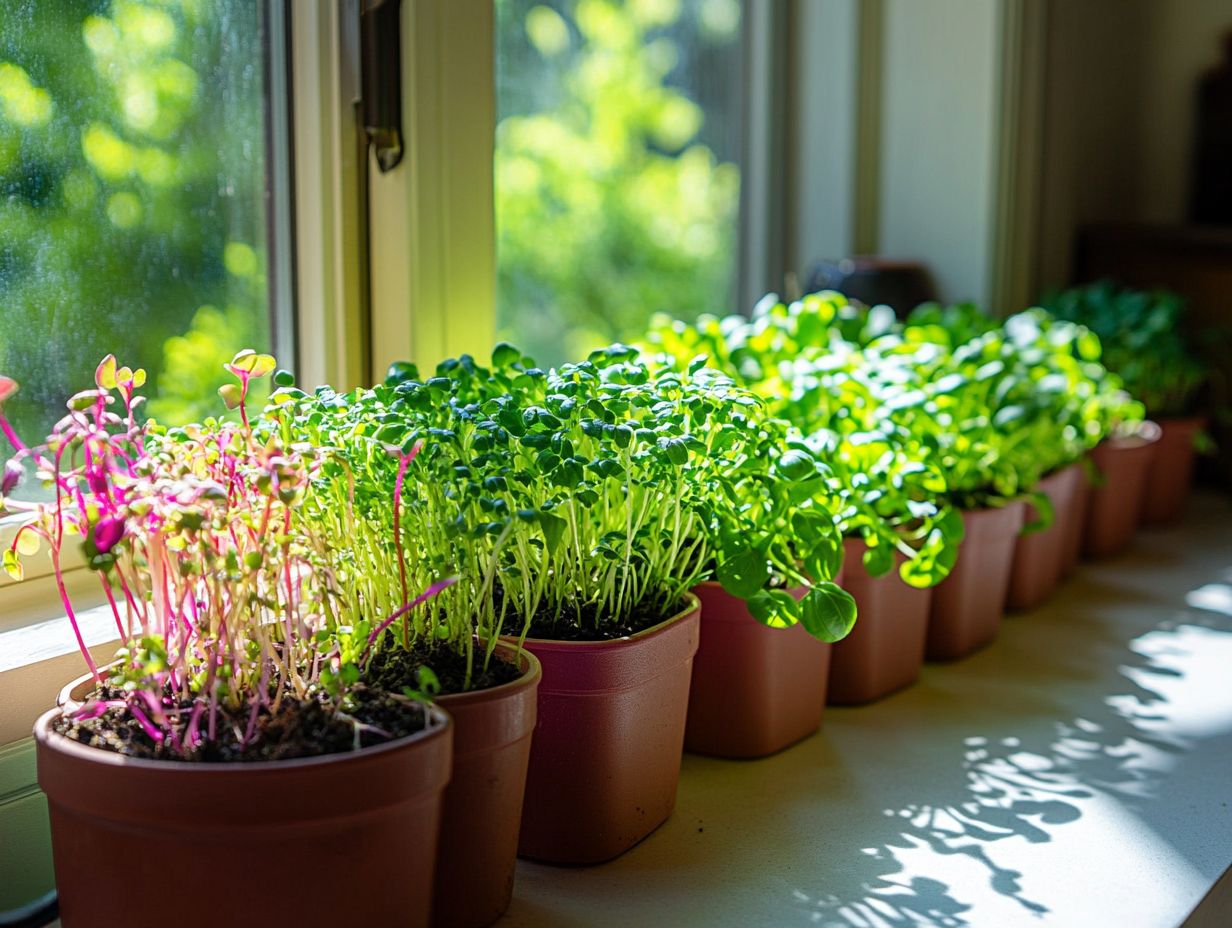
Harvesting and utilizing microgreens is one of the most exhilarating aspects of gardening. These diminutive greens are not only bursting with flavor but also elevate the nutritional value of your meals significantly.
Typically, the harvesting window for microgreens ranges from 7 to 21 days post-germination, depending on the variety. You can easily snip them just above the soil line when the time is right.
Once harvested, the possibilities are endless: you can garnish your dishes, incorporate them into salads, layer them in sandwiches, or even blend them into smoothies, allowing you to savor the freshness of microgreens across a wide array of culinary creations.
When and How to Harvest Microgreens
Understanding when and how to harvest microgreens is vital for savoring their peak flavor and nutritional benefits. These delicate greens are best picked just before they reach maturity. Typically, you ll find microgreens ready for harvest when their first leaves are fully developed, which usually occurs between 7 to 21 days post-sowing, depending on the variety.
To harvest, gently snip the microgreens just above the soil line using clean scissors, taking care to preserve the health of the root system for potential regrowth in certain varieties.
Harvesting at the right moment is crucial for the best flavor! Timing is essential; harvesting too early may leave you with a lackluster flavor, while waiting too long can lead to a bitter taste. The precision of your cut also plays a role in the overall quality; a clean, swift snip minimizes damage, ensuring that the essential vitamins and minerals that make microgreens so beneficial are preserved.
Using the right techniques enhances the taste and extends shelf life, allowing for a fresher product. By honing in on these methods, you can truly appreciate the unique flavors and nutritional offerings of various microgreens, enriching your culinary creations and boosting your health.
Exciting Ways to Add Microgreens to Your Meals!
Incorporating microgreens into your meals adds a delightful touch of flavor and a nutritional boost, making them a versatile ingredient for various cooking experiences. Whether you’re garnishing soups and salads, blending them into smoothies, or topping off sandwiches, the possibilities are endless and thrilling with fresh microgreens like arugula, basil, and sunflower.
Crafting microgreen recipes that showcase their unique flavors can elevate your dishes. Transform everyday meals into gourmet experiences packed with vitamins and antioxidants.
For example, when you sprinkle a handful of radish microgreens on creamy avocado toast, you are not just enhancing the visual appeal; you are introducing a peppery kick that elevates the overall taste.
You can fold them into savory dishes like omelets or grain bowls, where they bring vibrant color and freshness.
If you have a sweet tooth, blending sweet microgreens, such as strawberry or pea shoots, into a dessert smoothie offers a unique twist that s both delicious and nutritious.
Don t hesitate to experiment with microgreens in sauces and dressings, like a basil-infused pesto, as this can introduce new flavors, inviting your creativity to flourish in the kitchen.
Frequently Asked Questions
Got questions about growing microgreens indoors? Here are some common queries answered!
What are microgreen varieties that thrive indoors?
Some microgreen varieties that thrive indoors include broccoli, kale, radish, sunflower, and pea shoots.
Why do these specific microgreen varieties thrive indoors?
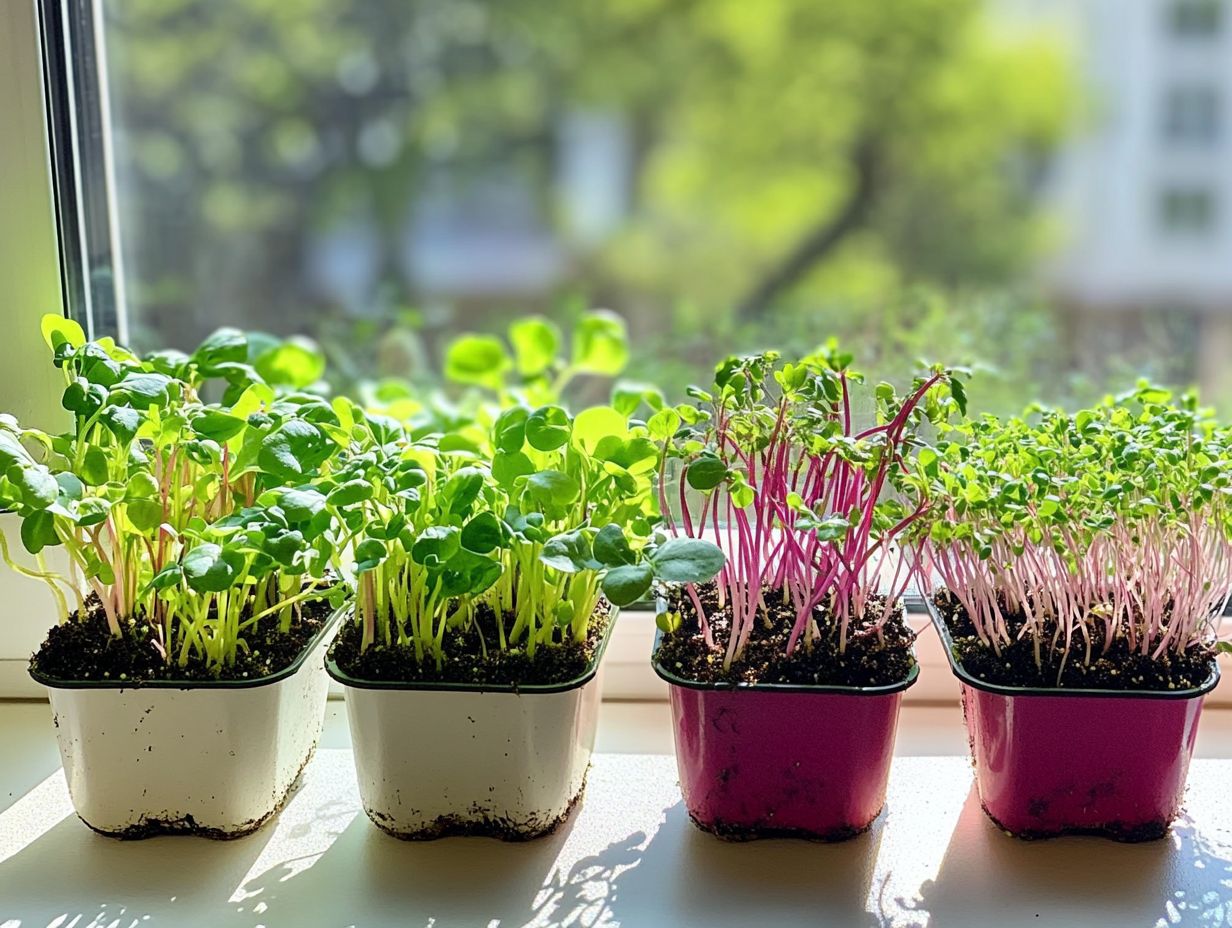
These microgreen varieties thrive indoors because they require minimal space, light, and soil to grow, making them perfect for indoor environments.
Can these microgreen varieties be grown in any type of indoor setting?
Absolutely! You can grow these microgreens in various indoor spots like windowsills, countertops, and even under grow lights.
Do these microgreen varieties require any special care when grown indoors?
These microgreen varieties require regular watering and proper lighting to thrive indoors. It is also important to keep the growing environment clean to avoid mold or pests.
How long does it take for these microgreen varieties to mature when grown indoors?
The maturation time for these microgreen varieties varies, but on average, it takes 1-2 weeks for them to reach their ideal harvesting size when grown indoors.
Are there any benefits to growing these microgreen varieties indoors?
Yes, there are many benefits to growing these microgreen varieties indoors. They are packed with nutrients and can be harvested at their peak freshness, making them a healthy and convenient addition to any diet. They also add a touch of greenery and freshness to indoor spaces.

